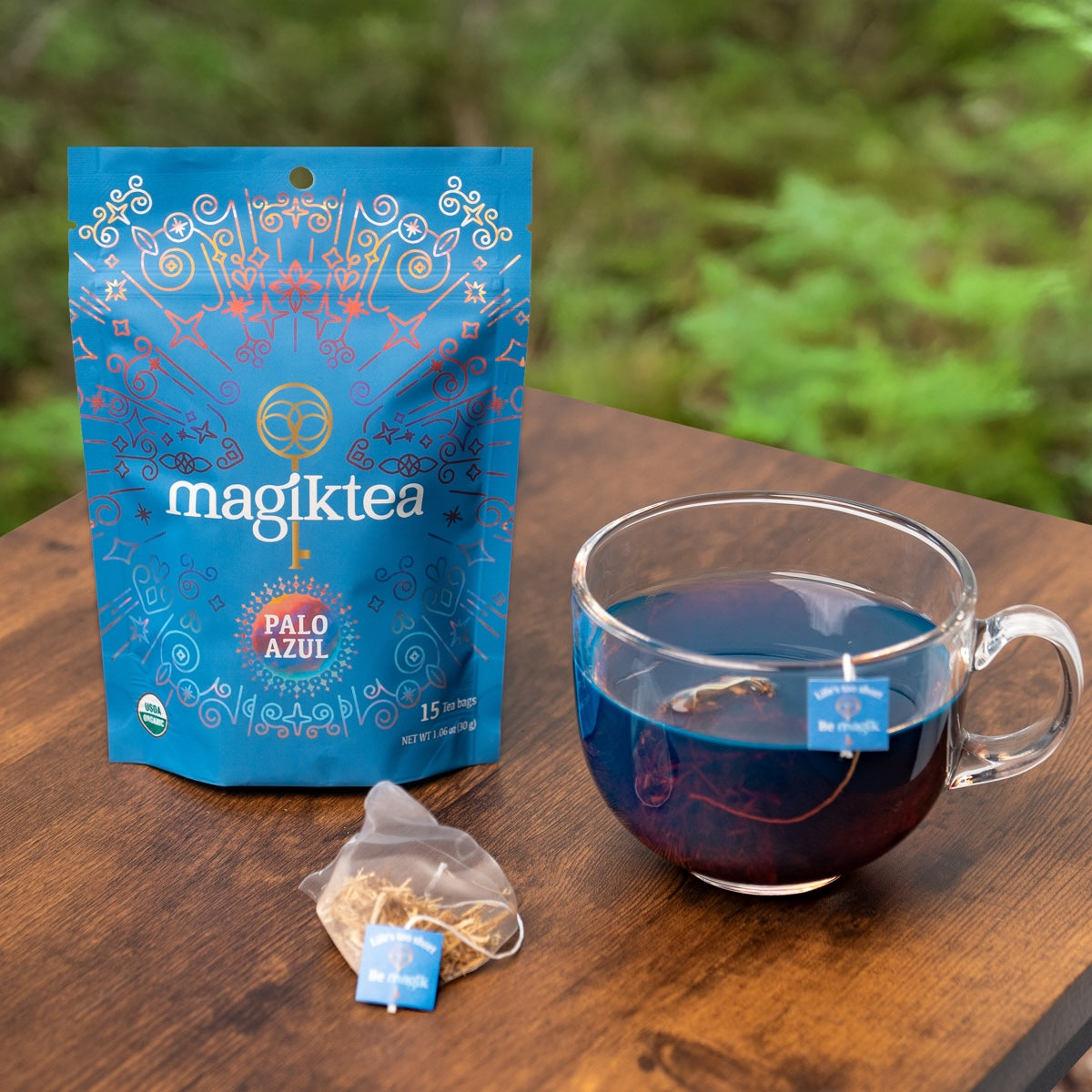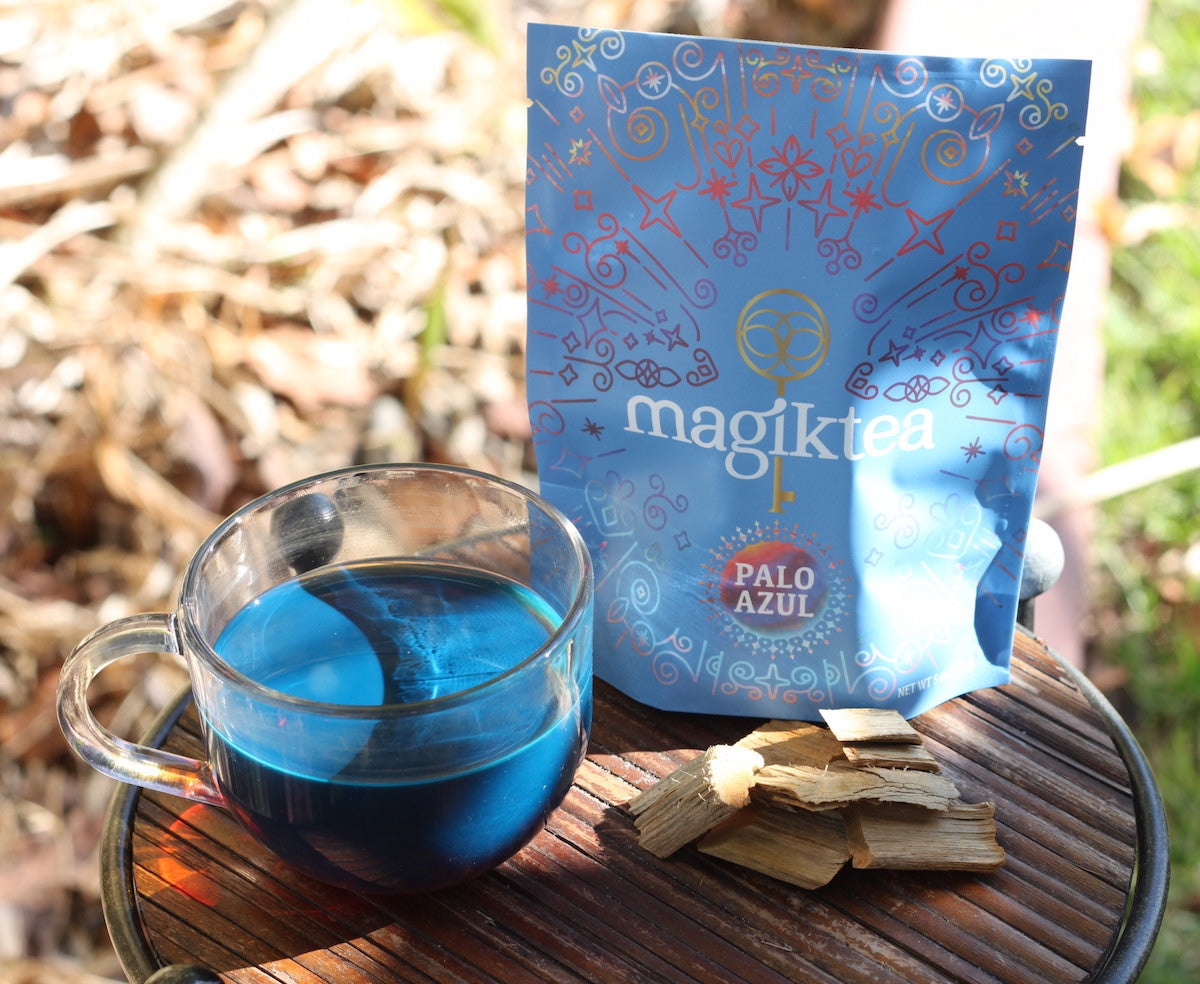Many of us like to drink tea because of its healing properties, but when non-biodegradable generic tea bags are exposed to heat, they can release toxic microplastics and other chemicals which end up in your body. Most tea bags are made from plastic, paper, or nylon…which is unfortunate because none of these materials are biodegradable and can therefore pollute the environment and contaminate the soil & ocean in which our food grows.
Our mission is to promote health & wellness by sharing palo azul tea with others, so we refuse to use low quality plastic or bleached paper tea bags which research has shown to be harmful for our health and the environment.
This is why our pyramid tea bags are made from a 100% biodegradable bio-mesh, which is a type of mesh made from PLA (Polylactic acid) that is derived from corn. They're more expensive than the conventional plastic or paper options, but we think it's worth it to have something that we know is better for our health and the planet.

Below we outlined our research on the harmful effects of plastic, paper, and nylon tea bags. In summary, conventional tea bags have microplastics, bleach, or other toxins which are endocrine disruptors, carcinogenic, and cause oxidative stress and inflammation. They also contribute to greenhouse gas emissions and contaminate the soil and oceans with toxins that can be reintroduced in our food chain.
1.) Plastic = Endocrine Disruptor

Microplastic pollution has recently garnered a lot of interest due to their harmful effects on human health and the environment. This is unfortunate for tea drinkers because many tea brands use tea bags that are made with plastic. So how bad is plastic?
A 2019 study found that “steeping a single plastic teabag at brewing temperature (95 °C) releases approximately 11.6 billion microplastics and 3.1 billion nanoplastics into a single cup of the beverage.” The authors mention that “the levels of nylon and polyethylene terephthalate particles released from the teabag packaging are several orders of magnitude higher than plastic loads previously reported in other foods.” Lastly, they found that “an initial acute invertebrate toxicity assessment shows that exposure to only the particles released from the teabags caused dose-dependent behavioral and developmental effects.”
Polyethylene terephthalate, is the most common thermoplastic polymer resin of the polyester family and is used in fibers for clothing, containers for liquids and foods.
A 2022 study also found that “ MPs (microplastics) from tea bags in Dhaka could cause an average emission of 10.9 million grams of MPs/year…making teabags an important route of human exposure to these micropollutants.”
How exactly are microplastics harmful to our health?

- A 2021 study explains the following reasons: “The large surface area of MPs could result in oxidative stress, cytotoxicity and translocation to distant tissues.”
- “Furthermore, the failure to remove MPs from the human body may induce chronic inflammation and increase the risk of cancer.”
A 2020 study which corroborates these findings, concluded that “microplastic exposure may cause particle toxicity, with oxidative stress, inflammatory lesions and increased uptake or translocation. The inability of the immune system to remove synthetic particles may lead to chronic inflammation and increase risk of neoplasia.”
Neoplasia is new, uncontrolled growth of cells that is not under physiologic control.

- Thirdly, and perhaps more importantly, numerous studies have shown that microplastics are endocrine disruptors. For example, this 2009 study mentions that “EEDCs (estrogen-like endocrine disruptor chemicals) have been found in various plastic products.” The authors explain that “EEDCs are exogenous, man-made chemicals that alter the functions of the endocrine system and cause various health defects by interfering with the synthesis, metabolism, binding or cellular responses of natural estrogens.”

The researchers go on to describe some of the health defects caused by endocrine disruptors: “The structural similarity of estrogen disruptors with estrogen allow them to bind and activate estrogen receptors and show a similar response even in the absence of estrogen that can lead to precocious puberty. In girls, they have been linked to earlier menarche and abnormal breast development. In boys, they showed a significant delay in puberty in pubertal boys and slowed down the timing of reproductive maturation.”
A 2013 study even showed that endocrine disruptors could have an epigenetic transgenerational effect, meaning that these health defects could be passed onto offspring. The researchers set out to evaluate where two endocrine disruptors, phthalates and BPA (Bisphenol A), promoted epigenetic transgenerational inheritance of adult onset disease and associated DNA methylation epimutations in sperm.”

They found that “there were significant increases in the incidence of total disease/abnormalities in male and female animals from plastics lineages. Pubertal abnormalities, testis disease, obesity, and ovarian disease (primary ovarian insufficiency and polycystic ovaries) were increased.”
Lastly, the researchers concluded the following: “Observations demonstrate that a mixture of plastic derived compounds, BPA and phthalates, can promote epigenetic transgenerational inheritance of adult onset disease.”
Are BPA free or cellulose tea bags ok?

Unfortunately…the answer is not so simple and it depends on the brand.
This 2011 study found that “most all commercially available plastic products we sampled—independent of the type of resin, product, or retail source—leached chemicals having reliably detectable EA (estrogenic activity), including those advertised as BPA free.”
Moreover, a 2021 study found that “4 out of 11 tea bags for use in teacups, called cellulose bags, contained plastics, whereas the figure for the tea bags for use in the teapot was 11 out of 11.” This paper concluded that “the analysis of 22 teabags revealed after treatment with SR, which is a strong solvent of cellulose, revealed that 15 had plastic content (an approximate 30–35 %).”
2.) Nylon = Microplastics & Greenhouse Gasses

This 2021 study analyzed tea bags from popular brands and the authors found that their “results demonstrated the presence of numerous plastic particles in the beverage obtained after steeping nylon tea bags, but the release of particles was further amplified after microwave treatment.” Moreover, they mention that “some branded teas are sold in tea bags made from so called “food grade” plastics (e.g. nylon), which is troubling since the teabags are exposed to high temperatures during the brewing process.”
The researchers concluded that “among 6 tea brands, 4 were observed to contain polypropylene (plastic) at various concentrations, whereas 1 was almost fully made of nylon, and the last one was considered to be biodegradable without any sign of plastics.”

This article mentions that “nylon tea bags are not the most sustainable choice as most nylon is practically non-biodegradable and cannot be composted. However, the long-term degradation time for nylon is shorter than many other forms of plastic, on the order of 30-40 years.” But that’s not the only problem with nylon…according to this article, “most nylon nowadays is produced by a process that generates significant amounts of nitrous oxide, which functions as a greenhouse gas and also depletes ozone.”
3.) White Paper = Bleached

The problem with paper tea bags isn’t necessarily due to microplastics, but they may have other harmful chemicals. A 2022 article explains “paper tea bags do not add plastics to your drink but bleach instead. This is because many producers want the paper to be as white as possible. To ensure this, the paper passes through a bleaching process.”
Moreover, the author explains that “the chlorine dioxide compound that is part of the bleaching method is usually left behind in the paper pulp in a concentration of 4.79 parts per trillion. Apart from chlorine, dioxins are chemicals that come along with paper as well. To increase the strength of paper tea bags, many producers even add epichlorohydrin. This is a carcinogenic substance that is toxic and harmful in the long run.”
How can chlorine dioxide, dioxins and epichlorohydrin affect our health?

This 1986 study assessed the toxicological problems with chlorine dioxide and found that there were “adverse health effects shown in animal experiments as well as human poisoning incidents.”
In addition, this 2010 review concludes that “dioxins are classified as known human carcinogens, but they also cause noncancerous effects like atherosclerosis, hypertension, and diabetes. Long-term exposures to dioxins cause disruption of the nervous, immune, reproductive, and endocrine system. Short-term exposure to high levels impairs the liver function and causes chloracne. A large number of health effects have been documented in the scientific literature, and they all place dioxins among the most toxic chemicals known to man.”
Lastly, this 1997 review mentions that “reports have shown it (epichlorohydrin) to cause the respiratory and dermal toxicity in animals and humans. It has also been reported to be carcinogenic in experimental models.” Also, the New Jersey Department of Health mentions that “epichlorohydrin is a carcinogen and mutagen.”
Heating tea bags = More chemicals

To make matters worse, when these tea bags are exposed to heat, they release even more microplastics and chemicals into the tea.
This 2022 study explains the following: “Given that even food-grade plastics may degrade or leach toxic substances when heated above 40 °C, brewing tea at ∼90 °C (frequently used temperature of brewing tea) raises serious environmental concern.”
A 2021 study also emphasizes that “whenever tea bags are used in brewing hot drinks, they may contain plastic fibers, posing potential health risks.”
Plastic Tea Bags Pollute & Contaminate the Environment

This 2021 study explains that “tea bags generally include plastic materials, which are difficult to degrade naturally. Plastic materials are not biodegradable and can cause various environmental problems such as bioaccumulation, shortening plant life, and release of microplastics. Waste tea bags are commonly disposed of via landfill or incineration.
Moreover, they mention the following: “On one hand, landfills emit gasses that contribute to global warming and present explosion hazards. Landfills can also contaminate the surrounding soil and groundwater. On the other hand, incineration of waste tea bags generates air pollutants such as polycyclic aromatic hydrocarbons (PAHs), dioxins, and particulate matter, which are detrimental to the environment and human health.”

Another 2021 study mentions that “the use of durable materials such as plastics in tea bags, which are purportedly compostable products, also constitutes a risk in terms of environmental sustainability.”
This 2022 article describes some other reasons why non-degradable tea bags can harm the environment: “A majority of tea bags are not biodegradable and will not turn into compost. They might end up in water bodies and can clog drains and pipes. If the tea bag is made using epichlorohydrin, it will definitely not decay or rot properly alongside other waste. Even animals might choke on them in some instances and possibly die.”

A 2021 article further explains that while tea bags may seem compostable, “if they actually contain plastic, they shouldn't be composted.” Otherwise, you would add “small amounts of plastic to the compost, which will introduce these chemicals back into the food chain as plants absorb them from the soil as they grow.”
Lastly, this article mentions that “the type of plastic most often used to seal the bags is polypropylene”, and this type of plastic is not biodegradable or recyclable, so you should throw these tea bags in the trash.
Conclusion
Non-biodegradable tea bags can be harmful to humans because they leach toxic microplastics and chemicals which are endocrine disruptors, carcinogenic, cause oxidative stress and inflammation. These tea bags can also be harmful to the environment by contributing greenhouse gas emissions and adding contaminants into the soil and oceans which can be reintroduced into our food chain. This is why you should only consume tea in 100% biodegradable tea bags made from organic material, or just use loose tea. Whichever path you choose, Magiktea's got you covered!
Sources
(2019) Plastic Teabags Release Billions of Microparticles and Nanoparticles into Tea
(2021) Spectral imaging for characterization and detection of plastic substances in branded teabags
(2009) Estrogen-like endocrine disrupting chemicals affecting puberty in humans--a review.
(2020) Environmental exposure to microplastics: An overview on possible human health effects
(2021) Valorization of waste tea bags via CO2-assisted pyrolysis
(2022) What Are Tea Bags Made Of?







